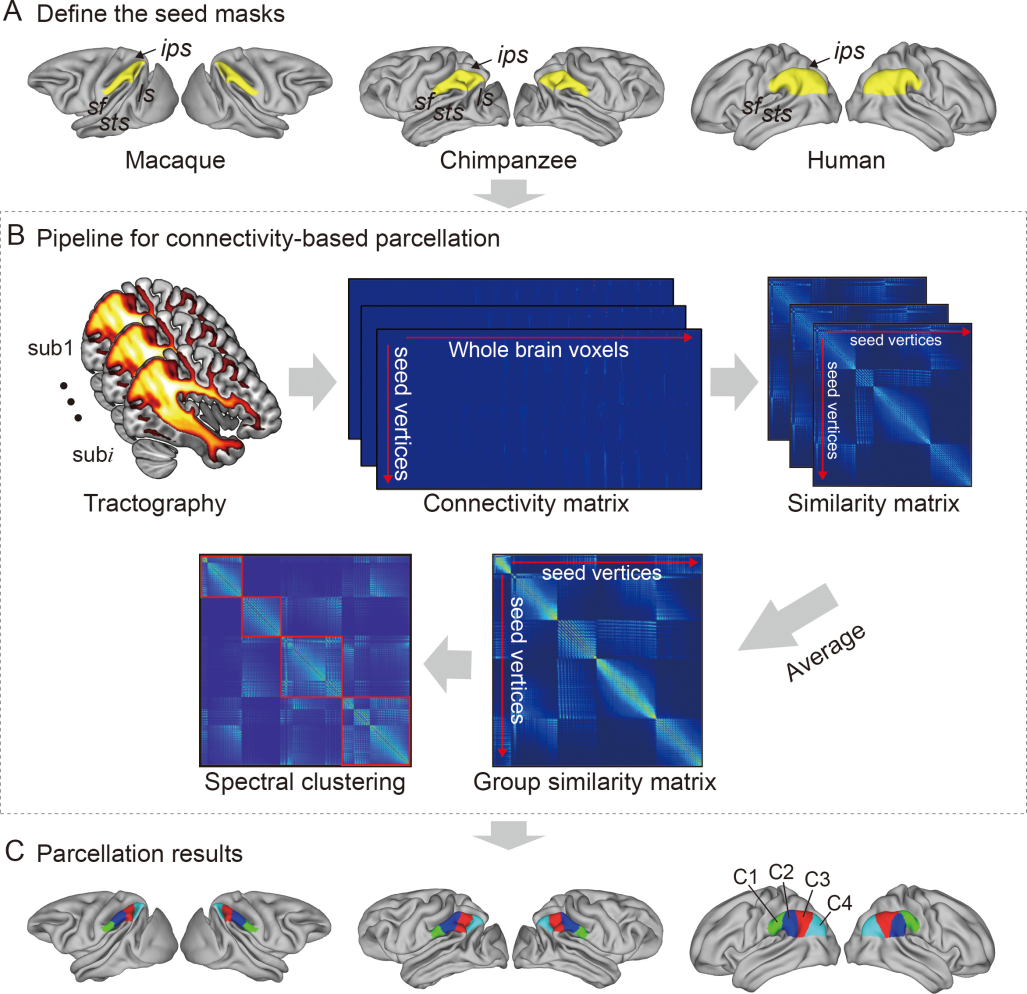- Home >> Latest News
Connectional asymmetry of the inferior parietal lobule shapes hemispheric specialization in humans, chimpanzees,and rhesus macaques
Luqi Cheng1,2,3, Yuanchao Zhang1, Gang Li2,3,4, Jiaojian Wang1,5, Chet Sherwood6, Gaolang Gong7,8, Lingzhong Fan2,3,4,9*, Tianzi Jiang1,2,3,4,9*
1Key Laboratory for NeuroInformation of Ministry of Education, School of Life Science and Technology, University of Electronic Science and Technology of China, Chengdu, China;
2Brainnetome Center, Institute of Automation, Chinese Academy of Sciences, Beijing, China;
3National Laboratory of Pattern Recognition, Institute of Automation, Chinese Academy of Sciences, Beijing, China;
4University of Chinese Academy of Sciences, Beijing, China;
5Center for Language and Brain, Shenzhen Institute of Neuroscience, Shenzhen, China;
6Department of Anthropology and Center for the Advanced Study of Human Paleobiology, The George Washington University, Washington, United States;
7State Key Laboratory of Cognitive Neuroscience and Learning & IDG/McGovern Institute for Brain Research, Beijing Normal University, Beijing, China;
8Beijing Key Laboratory of Brain Imaging and Connectomics, Beijing Normal University, Beijing, China;
9CAS Center for Excellence in Brain Science and Intelligence Technology, Institute of Automation, Chinese Academy of Sciences, Beijing, China
Abstract
The inferior parietal lobule (IPL) is one of the most expanded cortical regions in humans relative to other primates. It is also among the most structurally and functionally symmetric regions in the human cerebral cortex. Whether the structural and connectional asymmetries of IPL subdivisions differ across primate species and how this relates to functional asymmetries remain unclear. We identified IPL subregions that exhibited positive allometric in both hemispheres, scaling across rhesus macaque monkeys, chimpanzees, and humans. The patterns of IPL subregions asymmetry were similar in chimpanzees and humans, but no IPL asymmetries were evident in macaques. Among the comparative sample of primates, humans showed the most widespread asymmetric connections in the frontal, parietal, and temporal cortices, constituting leftward asymmetric networks that may provide an anatomical basis for language and tool use. Unique human asymmetric connectivity between the IPL and primary motor cortex might be related to handedness. These findings suggest that structural and connectional asymmetries may underlie hemispheric specialization of the human brain.
 | Figure 1. Framework of the connectivity-based brain parcellation for macaques, chimpanzees, and humans. (A) Defining the seed masks of the inferior parietal lobule (IPL) in surface space according to the gyri and sulci. (B) Connectivity-based parcellation using anatomical connectivity. Probabilistictractography was applied by sampling 5000 streamlines at each vertex within the seed mask. Whole-brain connectivity profiles were used to generate a connectivity matrix with each row representing the connectivity profile of each seed vertex. Next, a correlation matrix was calculated as a measure of similarity between the seed vertices. Then, a group similarity matrix was calculated by averaging the correlation matrix across subjects and spectral clustering was applied to it. (C) Parcellation results of the IPL across species. The entire framework was applied independently for each hemisphere and each species. |
